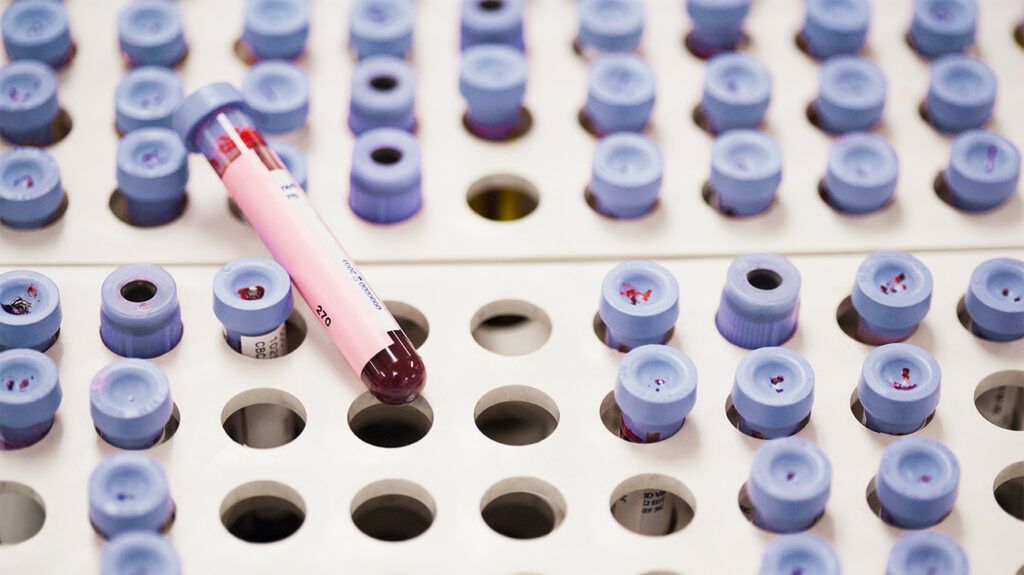All blood in the human body is red in color. It is untrue that deoxygenated blood is blue.
Human blood contains hemoglobin, which is a complex protein molecule in red blood cells. Hemoglobin contains iron. The iron reacts with oxygen, giving blood its red color. Oxygenated blood is a brighter, richer red color, while deoxygenated blood is darker, but still red.
In this article, we look at a variety of facts about blood, including color, types, and donation.

Although veins appear blue through the skin, blood is not blue. The reason why veins might seem to be blue may have to do with the level of oxygen in the blood.
The level or amount of oxygen in the blood determines the hue of red. As blood leaves the heart and is oxygen-rich, it is bright red.
It is a common myth that veins are blue because they carry deoxygenated blood. Blood in the human body is red regardless of how oxygen-rich it is, but the shade of red may vary.
When the blood returns to the heart, it has less oxygen. It is still red but will be darker. This darker red appears blue because of how light travels through the skin.
The exact amount of blood in the body varies according to a person’s size. The larger a person is, the more blood volume they have.
Approximately 7 to 8% of a person’s total weight is blood. That means an average-sized woman has about 9 pints of blood and an average-sized man about 12 pints.
How much blood can a person lose?
Profuse bleeding is a medical emergency, and there is no ‘safe’ amount of blood a person can lose.
If a person loses too much blood, it can lead to life-threatening complications such as hemorrhagic shock. This occurs when blood flow is not enough to sustain organ function. This occurs in stages, with the first stage involving a loss of
Everyone’s blood contains the same elements or components. Human blood contains red cells, white cells, platelets, and plasma. Even though all blood contains those same components, not everyone’s blood is alike.
There are different blood types based on the absence or presence of specific antigens and antibodies on the surface of the red blood cells. An antigen is a substance that can cause an immune system response in the body. The different blood types are:
- A+
- A-
- B+
- B-
- O+
- O-
- AB+
- AB-
A and B blood type
The two most common antigens are A and B. For example, people with blood type A have an A-antigen on their red blood cells, and people with type B blood have a B-antigen. Some people have both.
O blood type
People with O blood type do not have either A or B antigens on their red blood cells. Type O is the most common blood type worldwide.
Positive and negative blood types
Another antigen is a protein called the Rhesus (Rh) factor. People with this protein are considered Rh-positive. If the blood lacks the protein, they are Rh-negative.
Demographic trends
Anyone of any ethnic group can have any blood type, but there are some ethnic and racial trends.
In the United States, the following are the most common blood types based on different donor populations
According to the American Red Cross, the following statistics show the most common blood types in the U.S. based on the donor population:
- African American: 47% O-positive, 24% A-positive, and 18% B-positive
- Latin American: 53% O-positive, 29% A-positive, and 9% B-positive
- Asian: 39% O-positive, 27% A-positive, and 25% B-positive
- Caucasian: 37% O-positive, 33% A-positive, and 9% B-positive
Blood transfusions are when healthy blood from a donor is injected into a person who needs it. Common reasons to have a blood transfusion include:
- Severe blood loss from surgery, an accident, or childbirth.
- Anemia, when a person does not have enough red blood cells.
- Some types of cancer and cancer treatment, including chemotherapy.
- Conditions that affect the red blood cells, such as sickle cell disease.
If a person requires a blood transfusion, it is essential that the blood type they are given is a compatible type. If a person receives an incompatible blood type, their immune system may reject it. This can be life-threatening.
Most people can receive type O- blood safely, regardless of their blood type. This is why O- is often referred to as the ‘universal blood type’.
Without a blood transfusion, significant blood loss or severe anemia can be life-threatening. Donating blood can save lives. For those who are unsure about donating blood, it is helpful to consider the facts below:
- Someone needs blood approximately every
2 seconds . - Although research is underway to make synthetic blood, currently blood for transfusions only comes from donors.
- Typically, a person will donate just 1 pint of blood at a time.
- Most people do not develop side effects from donating blood.
Blood may appear blue through the skin, but it is always red.
Blood is essential for the functioning of the human body, but many myths about the body persist. Having accurate information about blood or any other aspect of health is vital. If someone suspects a health issue, it is essential to talk with a doctor to get the most accurate information.
